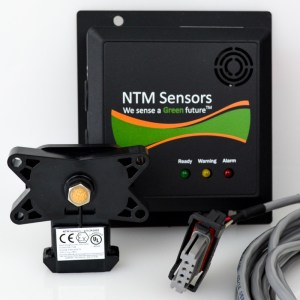 Hydrogen gas is often overlooked as a fuel due to the many safety concerns associated with it, but it is a common component in laboratory activities. Hydrogen gas is undetectable to the human senses and burns with an invisible flame. Furthermore, it is flammable at room temperatures in concentrations as low as four percent in air. As the smallest molecule known to man, diatomic hydrogen is difficult to contain. Taking these characteristics into consideration, safety measures are essential when working with hydrogen. Typical examples include: detecting the presence of hydrogen, preventing and minimizing potential leaks when possible, ensuring proper ventilation, limiting ignition sources, and preventing propagation of a hydrogen ignition or explosion.
Hydrogen gas is often overlooked as a fuel due to the many safety concerns associated with it, but it is a common component in laboratory activities. Hydrogen gas is undetectable to the human senses and burns with an invisible flame. Furthermore, it is flammable at room temperatures in concentrations as low as four percent in air. As the smallest molecule known to man, diatomic hydrogen is difficult to contain. Taking these characteristics into consideration, safety measures are essential when working with hydrogen. Typical examples include: detecting the presence of hydrogen, preventing and minimizing potential leaks when possible, ensuring proper ventilation, limiting ignition sources, and preventing propagation of a hydrogen ignition or explosion.
Since some hydrogen leakage and the presence of ignition sources is often unpreventable, such as in the testing of solid oxide fuel cells, ventilation and detection are the most important preventative safety features in a hydrogen-containing laboratory. Ventilation reduces the risk of leaked hydrogen gas building up to flammable concentrations in the laboratory. Since hydrogen is such a light molecule, it can accumulate near the ceiling unless forced ventilation systems are used in which air extraction occurs at the highest point in the room. However, even with ventilation hydrogen can still accumulate in areas where the air flow is stagnant. Therefore, detection is important as it provides an additional level of safety and allows for potential mitigation strategies to be used when there is a large release of this highly flammable gas or ventilation systems fail.
A detection system, which consists of both a sensor and alarm, is the most critical feature of any hydrogen-containing laboratory.
A detection system, which consists of both a sensor and alarm, is the most critical feature of any hydrogen-containing laboratory. Detection systems can provide early warning of a potential hazard and allow for preventative actions to be taken, such as closing off the source. Hydrogen sensor technology continuously monitors hydrogen levels and can detect hydrogen gas in the ppm range of concentration. Hydrogen sensors typically measure concentrations from zero to ten percent and are accurate in a wide range of humidity and ambient temperature conditions. Many hydrogen detection systems are equipped with mechanical relays to allow for automatic corrective actions when hydrogen readings reach defined levels. For example, a hydrogen sensor can be used in tandem with a forced ventilation system to safely and dynamically manage a hydrogen leak. No matter how this gas is used in a laboratory, a reliable detection system is essential in safely managing the many hazards associated with hydrogen.
Hydrogen Tips from a Fuel Cell Testing Engineer | |
|---|---|
When testing SOFC stacks the following practices will further improve the hydrogen safety in the laboratory.
| |
[/vc_column_text][vc_separator color=”custom” border_width=”2″ accent_color=”#99cc33″][vc_column_text]
Upgrade Your Lab to Meet Today’s Hydrogen Safety Best Practices.
Installing a hydrogen detection system in your lab is the quickest way to make sure you are up-to-date on the latest hydrogen safety best practices.
Talk to the experts at NTM Sensors about adding a hydrogen detection system today.
[/vc_column_text][vc_separator color=”custom” border_width=”2″ accent_color=”#99cc33″][/vc_column_inner][/vc_row_inner][/vc_column][/vc_row][vc_row][vc_column][vc_separator][/vc_column][/vc_row]
